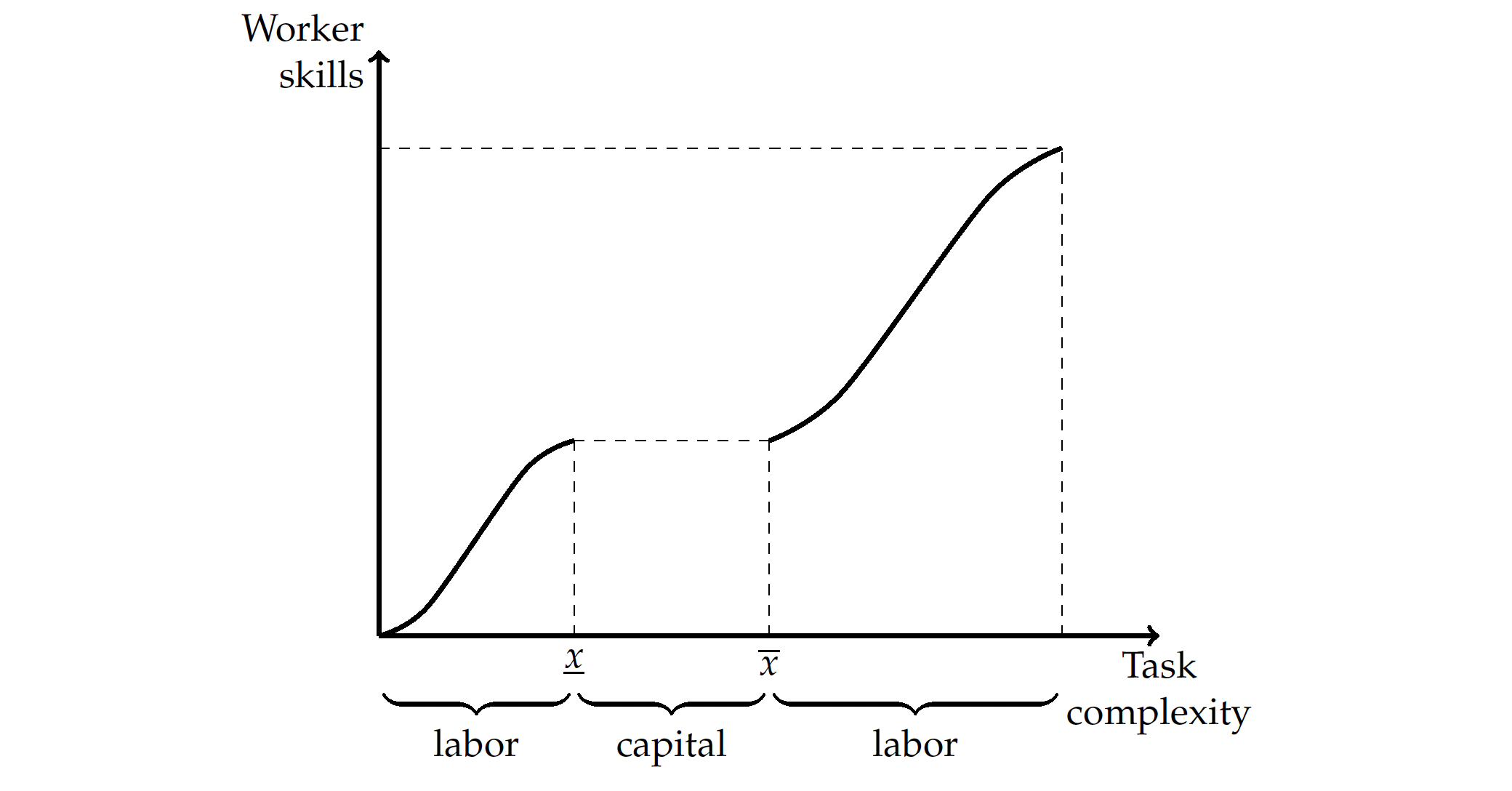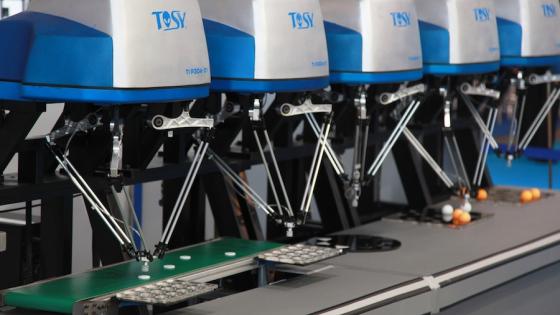Automation technologies have spread rapidly throughout the advanced economies during the last decades. The number of industrial robots per worker in the US economy increased from 0.38 to 1.8 between 1993 and 2017, while the share of information technology in overall US investment rose from 3.5% to 23% between 1950 and 2020. These developments have caused fears of widespread displacement of workers and sparked a debate about the future role of human labour in the economy (e.g. Mokyr et al. 2015).
A growing body of evidence has documented the consequences of automation. Much of this evidence points to its polarising impact. Autor and Dorn (2013) and Goos et al. (2009), for example, show that information technologies have reduced employment and wages in occupations located in the middle of the wage distribution, both in the US and Europe. Evidence provided in Graetz and Michaels (2018), Acemoglu and Restrepo (2020) and Dauth et al. (2021) suggests that industrial robots have also had their biggest impact on middle-skill occupations.
Why automation has caused this type of polarisation is less fully understood.
Polanyi’s paradox
The leading explanation is proposed by Autor (2014), who suggests that automating middle-skill jobs was easier than automating lower- and higher-skill jobs. This is because middle-skill jobs were characterised by repetitive cognitive tasks, which are particularly suitable for computer-based automation. Jobs at the lower end of the wage or skill distribution, on the other hand, involve a greater share of manual tasks, which humans can perform intuitively without being able to explain exactly how they do it. In this way, Autor suggests that polarising effects of automation are related to Polanyi’s (1966) claim that “we know more than we can tell”. The lack of a precise set of instructions means that computers could not take over these tasks. This view has been highly influential in shaping the debate about the effects of existing automation and its future course (e.g. Frey and Osborne 2013, Arntz et al. 2017).
Low wages
In a new paper (Acemoglu and Loebbing 2022), we revisit why automation has led to the erosion of middle-wage occupations. We propose a general equilibrium model where workers with different levels of skills compete with machines for jobs of various levels of complexity.
Figure 1 illustrates the key condition for interior automation, whereby jobs in the middle of the wage distribution are automated. This condition requires wages at the bottom of the skill distribution to be low relative to the productivity advantage of machines over humans in these jobs.
Figure 1
Source: Acemoglu and Loebbing (2022).
Notes: The mapping from tasks, ordered by complexity, to workers, ordered by skill level. A range of tasks of intermediate complexity is taken over by capital while tasks at the extremes of the distribution are performed by workers.
This condition confirms that Polanyi’s paradox can account for the pattern of automation we have observed so far, as Autor (2014) suggested — the productivity advantage of machines relative to humans may be particularly pronounced in middle-skill jobs. However, it also proposes a new perspective on polarisation. Interior automation and the resulting polarisation may be consequences of the fact that wages are low at the bottom of the wage distribution, making the automation of low-pay jobs unprofitable. Whether wages are low at the bottom is determined by the entire distribution of productivities and skill supplies, as well as institutional factors (e.g. lack of binding minimum wages for low-skill workers).
When automation is interior, further advances in machine productivity create greater labour market polarisation, pushing workers towards the lower and higher ends of the job complexity distribution. Its impact on inequality tends to be nuanced, however. It is workers closest to the middle of the distribution who experienced the largest relative declines in wages. In particular, lowest-skill workers are partially shielded from the adverse effects of automation, because they are far away from jobs that are being automated.
In fact, our framework clarifies that the workers who will experience declines in their real wages are those who are most similar to machines in terms of their comparative advantage. This refines a conjecture by Norbert Wiener (1950), who suggested: “the automatic machine is the precise economic equivalent of slave labour. Any labour which competes with slave must accept the economic consequences of slave labour.” In our model, this is not true for all labour, but only for certain types of labour that are very close to machines. These tend to be workers with middle skills when automation is interior. Other types of workers will generally experience higher earnings, because automation also increases productivity and labour demand for complementary types of labour.
Future automation
Why automation has so far been interior and polarising has implications for the future of automation. If Polanyi’s paradox is the reason, then only major technological breakthroughs that enable machines to expand their reach to jobs that involve a significant manual and non-routine component can expand automation to low-skill, low-pay occupations. If, on the other hand, it is low wages that have slowed down the automation of these jobs, further improvements in machine productivity (declines in the cost of automation capital) can expand automation to lower-pay occupations.
Our framework thus emphasises that the next stage of automation may easily encroach more of low-pay occupations, and also clarifies that if this happens there will be a qualitative difference in its distributional effects. Once we transition to this next phase that involves machines substituting for low-skill workers in low-pay occupations, automation will no longer create polarising effects, but will instead cause a uniform increase in inequality. Specifically, if we transition to low-skill automation, as illustrated by the right-hand panel of Figure 2, low-skill workers will experience earnings decline relative to high-skill workers.
Figure 2
Source: Acemoglu and Loebbing (2022).
Notes: Starting from a situation of interior automation, an increase in the productivity of machines pushes workers further towards the extremes of the task distribution, inducing employment polarisation (left panel). If machine productivity increases sufficiently, machines take over all tasks at the lower end of the complexity distribution and further improvements in machine productivity push all workers towards more complex tasks (right panel).
Conclusion
Automation technologies are likely to continue to spread throughout the labour markets of both industrialised and emerging economies. Why automation so far has led to labour market polarisation has important implications for the future of automation and inequality. Our research suggests that low wages at the bottom of the distribution may have been an important factor encouraging automation to concentrate in the middle of the skill distribution, and if so, the next stage of automation may have qualitatively different implications, distinct from its so far polarising effects.
References
Acemoglu, D and P Restrepo (2020), “Robots and Jobs: Evidence from US Labor Markets,” Journal of Political Economy 128(6): 2188-2244 (see also “Robots and Jobs: Evidence from the US,” VoxEU.org, 10 April 2017).
Acemoglu, D and J Loebbing (2022), “Automation and Polarization,” NBER Working Paper 30528.
Arntz, M, T Gregory and U Zierahn (2017), “Revisiting the Risk of Automation,” Economics Letters 159: 15-160.
Autor, D (2014), “Polanyi’s Paradox and the Shape of Employment Growth,” NBER Working Paper 20485.
Autor, D and D Dorn (2013), “The Growth of Low-Skill Service Jobs and the Polarization of the US Labor Market,” American Economic Review 103(5): 1553-1597.
Autor, D, L Katz and M Kearney (2006): “The Polarization of the US Labor Market,” American Economic Review 96(2): 189-194.
Dauth, W, S Findeisen, J Suedekum, N Woessner (2021), “The Adjustment of Labor Markets to Robots,” Journal of the European Economic Association, 19(6), 3104-3153 (see also: “The Rise of Robots in the German Labor Market,” VoxEU.org, 19 September 2017).
Frey, C and M Osborne (2013), “The Future of Employment: How Susceptible are Jobs to Computerisation?”, Technological Forecasting and Social Change 114: 254-280.
Goos, M, A Manning and A Salomons (2009), “Job Polarization in Europe,” American Economic Review 99(2): 58-63.
Graetz, G and G Michaels (2018), “Robots at Work,” Review of Economics and Statistics 100(5): 753-768 (see also: “Estimating the Impact of Robots on Productivity and Employment,” VoxEU.org, 18 March 2015).
Mokyr, J, C Vickers and N Ziebarth (2015), “The History of Technological Anxiety and the Future of Economic Growth: Is This Time Different?”, Journal of Economic Perspectives 29(3): 31-50.
Polanyi, M (1966), The Tacit Dimension, Doubleday.
Wiener, N (1950), The Human Use of Human Beings: Cybernetics and Society, Houghton Mifflin.





